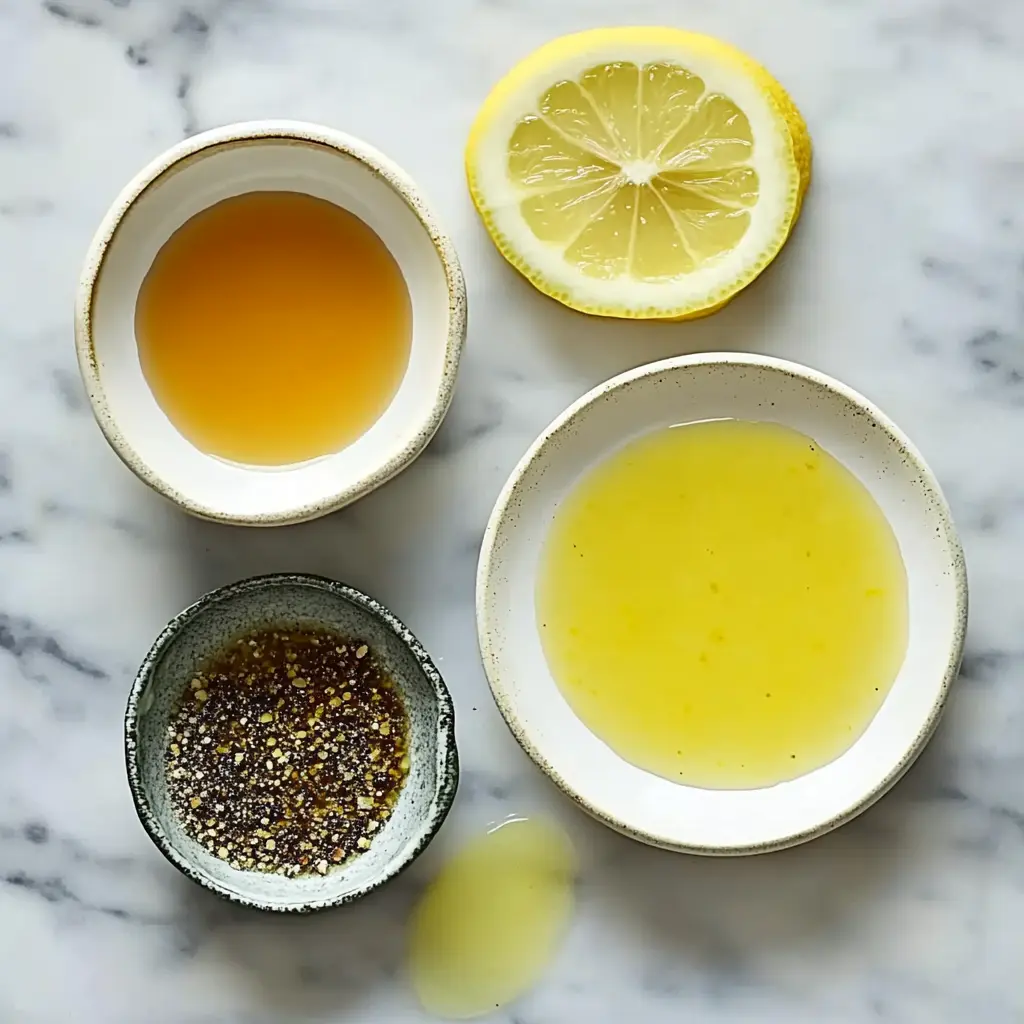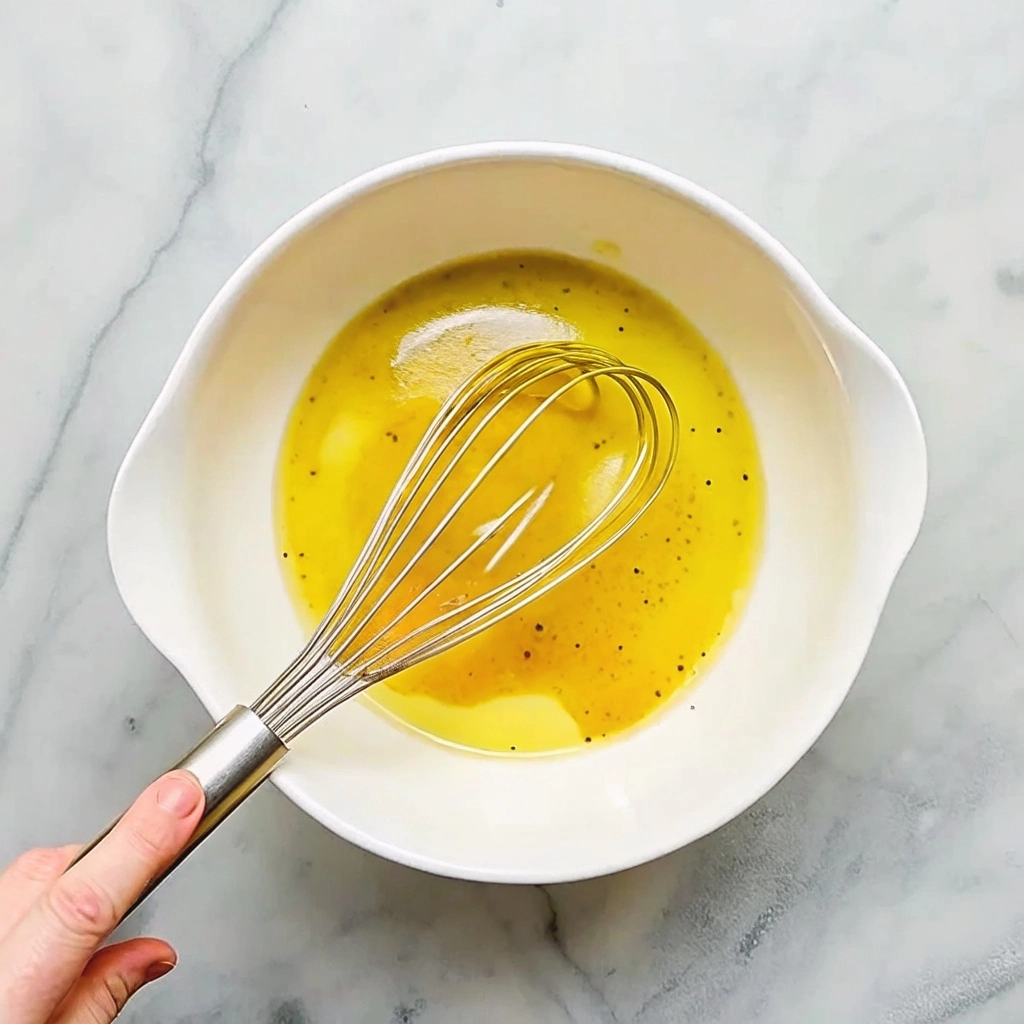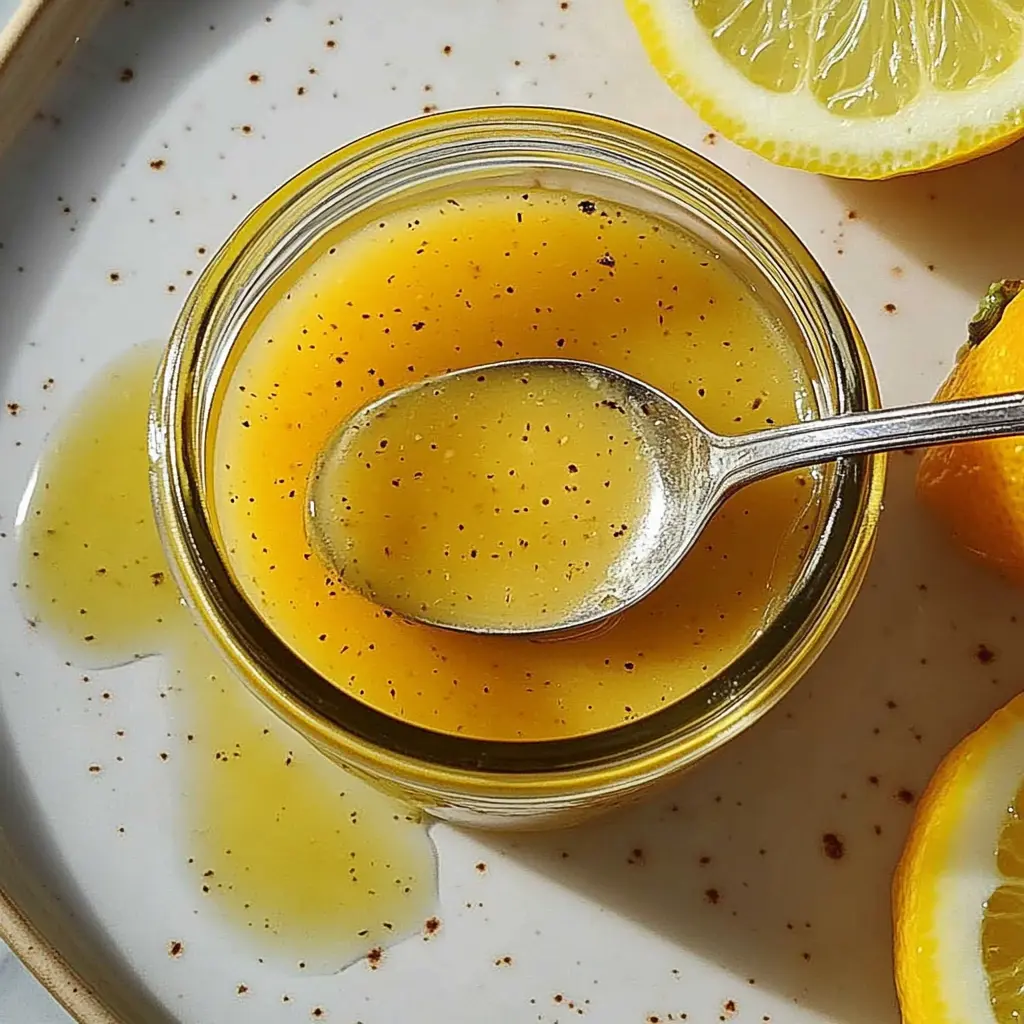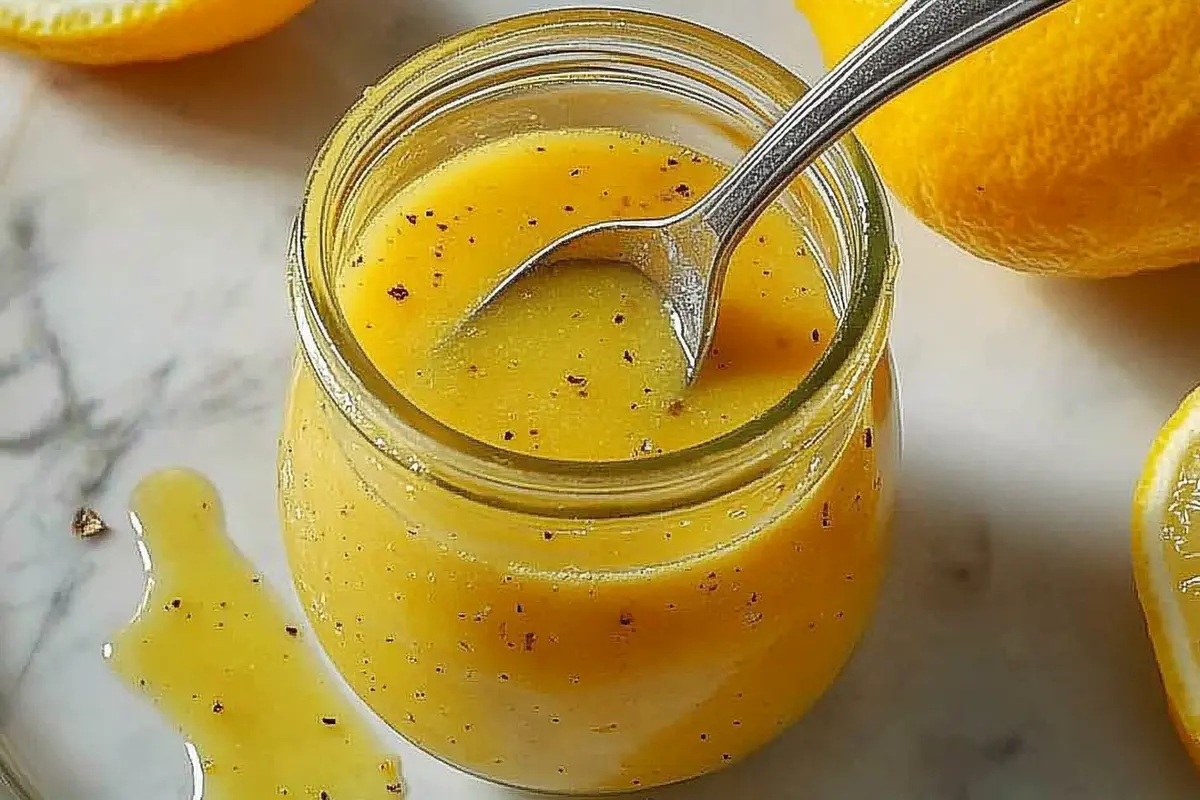What Is Lemon Vinaigrette?
Lemon vinaigrette is a type of vinaigrette dressing that uses fresh lemon juice as its primary acidic component. Unlike vinegar-based vinaigrettes, the citrus brightness from lemons imparts a lively, fragrant profile that pairs beautifully with mild greens, hearty grains, and even grilled proteins. The classic formula combines an acidic element (in this case, lemon juice), a neutral or flavorful oil, and seasoning—often stabilized with an emulsifier such as Dijon mustard.
Definition and Basic Concept
- Acid Source: Fresh lemon juice provides a bright, tangy flavor that stimulates the palate.
- Oil Component: Extra-virgin olive oil contributes a smooth, fruity mouthfeel.
- Emulsifier: Ingredients like Dijon mustard or a touch of honey help bind the oil and acid, preventing separation.
- Seasonings: Simple additions such as salt, pepper, and choice aromatics round out the profile.
Compared to store-bought dressings, Homemade Lemon Vinaigrette offers unparalleled freshness. You choose the type of oil, the level of acidity, and which aromatics or herbs to include. Because it relies on fresh lemons, it has a more vibrant character than bottled lemon juice or pre-made citrus concentrates.check out Understanding Vinaigrette Basics
Benefits of Homemade Lemon Vinaigrette
Creating your own Homemade Lemon Vinaigrette unlocks several advantages that transform ordinary dishes into standout culinary experiences:
- Flavor Customization
- Adjust the ratio of lemon juice to oil for a tangier or milder taste.
- Choose premium extra-virgin olive oil for a grassy note or try a neutral oil (grapeseed, avocado) for a subtler base.
- Incorporate aromatics like garlic or shallots to create a distinct profile tailored to your preferences.
- Cost Savings
- Buying lemons and a bottle of quality olive oil can be more economical than purchasing multiple bottles of specialty dressings.
- You can make larger or smaller batches based on need, reducing food waste.
- Ingredient Control
- Avoid preservatives, artificial flavors, or unnecessary sweeteners often found in store-bought vinaigrettes.
- Select organic or sustainably sourced ingredients to support environmental and ethical considerations.
- Freshness and Quality
- Using fresh lemons ensures maximum vibrancy and natural zest.
- Homemade dressings maintain their peak flavor for several days when stored properly.
- Versatility
- Beyond salads, this vinaigrette doubles as a marinade, sauce drizzle, or even a light dip.
- Easily convert into variations—honey-mustard, garlic-infused, or herb-centric dressings—by adjusting a few ingredients.
Key Ingredients and Their Roles
Understanding the function of each component in your Homemade Lemon Vinaigrette is crucial to mastering the final product. Below is an in-depth look at the core ingredients and how they contribute to the overall dressing.
Fresh Lemons
- Acid Source: Fresh lemon juice provides zesty brightness that contrasts the richness of oils.
- Zest: Including lemon zest intensifies the citrus aroma without adding additional liquid.
- Varieties: Meyer lemons are sweeter and less acidic, while Eureka or Lisbon lemons deliver a sharper tang.
- Quality Tip: Choose firm lemons with smooth, glossy skins—avoid ones that feel spongey or have blemishes.
Oils
- Extra-Virgin Olive Oil:
- Offers a fruity, peppery note that pairs seamlessly with lemon juice.
- Ideal for those seeking a robust, Mediterranean-style dressing.
- Neutral Oils (Grapeseed, Avocado, Sunflower):
- Provide a milder taste for a more subdued base.
- Recommended if you prefer the lemon flavor to take center stage.
- Oil Selection Tips:
- Look for cold-pressed, unrefined bottles labeled “extra-virgin” to ensure optimum flavor.
- Store oils in a cool, dark place to maintain freshness.
Emulsifiers and Binders
- Dijon Mustard:
- A classic emulsifier that binds oil and acid, preventing separation.
- Contributes a mild spicy undertone to the vinaigrette.
- Honey or Agave Syrup:
- Adds subtle sweetness and aids in emulsification.
- Helps round out the acidity of the lemon juice.
- Mayonnaise or Greek Yogurt (Optional):
- For a creamy lemon vinaigrette, a spoonful of mayonnaise or yogurt creates a rich mouthfeel.
- Use sparingly to avoid overpowering the citrus notes.

Seasonings and Aromatics
- Salt:
- Enhances the natural flavors of all ingredients.
- Use fine sea salt or kosher salt for even distribution.
- Freshly Ground Pepper:
- Balances the acidity with a mild, peppery edge.
- Grind fresh just before mixing for maximum aroma.
- Garlic vs. Shallots:
- Raw Garlic: Delivers sharp pungency; mincing or pressing releases its oils directly into the dressing.
- Roasted Garlic: Yields a milder, sweeter note; mash and blend for a smoother finish.
- Shallots: Provide a subtler onion-like flavor; finely minced shallots offer a refined layer of taste.
- Fresh Herbs (Parsley, Chives, Basil):
- Parsley: Bright and slightly peppery—complements lemon’s zest.
- Chives: Mild onion flavor; ideal for delicate flavor profiles.
- Basil: Sweet and aromatic; works well in Italian-inspired salads.
- Optional Sweeteners (Maple Syrup, Agave):
- Balance out extreme acidity when using particularly sour lemons.
- Add one teaspoon at a time to avoid making the vinaigrette overly sweet.
- Spices and Flavor Boosters:
- Crushed Red Pepper Flakes: Impart a gentle heat.
- Dried Oregano or Thyme: Introduce Mediterranean undertones.
- Smoked Paprika: Provides a subtle smokiness, ideal for grilled dishes.
By carefully choosing and adjusting these components, you ensure your Homemade Lemon Vinaigrette aligns perfectly with your desired flavor profile.
Step-by-Step Basic Lemon Vinaigrette Recipe
Below is a detailed, step-by-step breakdown of how to prepare a classic Homemade Lemon Vinaigrette. Follow each step closely to achieve the perfect balance of tang, richness, and complexity.
1. Gather and Measure Ingredients
- Ingredients:
- ¼ cup fresh lemon juice (approximately 2 large lemons)
- 1 teaspoon lemon zest (finely grated)
- ¾ cup extra-virgin olive oil
- 1 tablespoon Dijon mustard
- 1 teaspoon honey or agave syrup (optional for sweetness)
- 1 small garlic clove, minced (or 1 teaspoon shallots, finely chopped)
- ½ teaspoon fine sea salt (adjust to taste)
- ¼ teaspoon freshly ground black pepper (adjust to taste)
- 1 tablespoon fresh herbs (parsley or chives), minced (optional)
- Preparation Checklist:
- Juice and zest lemons before assembling to prevent oxidation.
- Mince garlic or shallots just before mixing to preserve freshness.
- Ensure all ingredients are at room temperature for best emulsification.
2. Juicing and Zesting Lemons
- Juicing:
- Roll each lemon on the countertop with gentle pressure to loosen juices.
- Cut the lemons in half crosswise and use a citrus juicer or manual reamer to extract juice into a small bowl.
- Tip: Scrape pulp that clings to the juicer to capture every last drop of lemon juice.
- Zesting:
- Use a microplane or fine grater to remove the outermost yellow layer of the lemon rind—avoid the bitter white pith.
- Collect zest in a small pile and set aside.
3. Combining Emulsifiers with Lemon Juice
- Mixing Base:
- In a small mixing bowl, whisk together:
- ¼ cup fresh lemon juice
- 1 teaspoon Dijon mustard
- 1 teaspoon honey or agave syrup (if using)
- ½ teaspoon sea salt
- ¼ teaspoon freshly ground black pepper
- Whisk briskly until the mustard dissolves and the mixture is smooth.
- In a small mixing bowl, whisk together:
- Incorporate Zest:
- Fold in 1 teaspoon of lemon zest to infuse extra citrus aroma.

4. Slowly Drizzling in Oil
- Emulsification Technique:
- By Hand (Whisk):
- Hold a steady, thin stream of extra-virgin olive oil in one hand.
- With the other hand, whisk the mustard-lemon base vigorously as you slowly add the oil.
- Continue whisking in a circular motion until the oil is fully incorporated and the mixture becomes opaque and creamy.
- Using a Blender or Mini-Food Processor:
- Combine the lemon juice mixture in the blender jar.
- Blend on low speed as you pour all oil in a steady stream through the spout.
- Blend until the dressing is thickened and emulsified.
- By Hand (Whisk):
- Benefits of Each Method:
- Whisking by hand gives you control and a rustic texture.
- A blender or mini-food processor yields a silky, ultra-smooth vinaigrette.
5. Seasoning to Taste
- Adjust Acidity:
- Taste the vinaigrette. If it’s too tangy, whisk in an extra teaspoon of honey or agave.
- If it’s too mild, add a teaspoon more fresh lemon juice.
- Enhancing Flavor:
- Stir in 1 tablespoon of minced fresh herbs (parsley, chives, or basil) for added aroma.
- Add minced garlic or shallots if you prefer a stronger bite.
- Final Seasoning:
- Adjust salt and pepper in ¼-teaspoon increments until the dressing sings.
- Whisk one final time to ensure all ingredients are evenly dispersed.
6. Storing or Serving Immediately
- Serving Right Away:
- Transfer the vinaigrette to a small pouring jar or cruet.
- Drizzle over mixed greens, grain salads, or use as a marinade.
- Storing for Later:
- Pour the dressing into a clean, airtight glass jar or bottle.
- Seal tightly and refrigerate.
- Shake or whisk vigorously before each use, as separation is natural over time.
Common Variations on Lemon Vinaigrette
Experimenting with flavor variations allows you to tailor Homemade Lemon Vinaigrette to specific dishes. Below are several popular riffs on the classic recipe:
1. Honey-Mustard Lemon Vinaigrette
- Ingredients Adjustments:
- Use 2 tablespoons honey instead of 1 teaspoon.
- Increase Dijon mustard to 2 tablespoons for additional emulsification.
- Flavor Profile:
- Sweeter, with a gentle mustard bite.
- Ideal for pairing with bitter greens (arugula, radicchio) or as a glaze for roasted root vegetables.
- Usage Suggestions:
- Drizzle over a spinach and strawberry salad with candied walnuts.
- Toss with roasted Brussels sprouts and bacon.
2. Garlic-Infused Lemon Vinaigrette
- Ingredients Adjustments:
- Increase minced garlic to 2 cloves (roasted for mellower taste, raw for a sharper bite).
- Omit honey unless you want to balance intense garlic flavor.
- Flavor Profile:
- Robust, aromatic, and slightly spicy.
- Perfect for hearty salads, grilled vegetables, or pasta salad.
- Usage Suggestions:
- Coat grilled asparagus or zucchini before searing.
- Use as a marinade for chicken breasts or shrimp skewers.
3. Herb-Loaded Lemon Vinaigrette
- Ingredients Adjustments:
- Increase fresh herbs to 3 tablespoons (combination of parsley, basil, and chives).
- Omit additional sweeteners unless desired.
- Flavor Profile:
- Bright, herbaceous, and fragrant.
- Great for Mediterranean-inspired grain bowls or as a finishing drizzle on bruschetta.
- Usage Suggestions:
- Toss with orzo pasta, cherry tomatoes, and feta cheese for a refreshing side.
- Use as a dressing for watermelon-feta salad with mint.
4. Spicy Lemon Vinaigrette
- Ingredients Adjustments:
- Add ¼ teaspoon crushed red pepper flakes or 1 small minced chili pepper.
- Include 1 teaspoon honey to balance heat.
- Flavor Profile:
- Zesty citrus meets a pleasant kick of spice.
- Pairs beautifully with spicy dishes or bold, robust salads.
- Usage Suggestions:
- Drizzle over a black bean and corn salad for Southwestern flair.
- Use as a sauce for grilled chicken tacos or shrimp tostadas.
5. Creamy Lemon Vinaigrette
- Ingredients Adjustments:
- Add 2 tablespoons mayonnaise or plain Greek yogurt.
- Reduce oil to ½ cup to maintain balanced consistency.
- Flavor Profile:
- Rich and velvety, yet still bright from lemon juice.
- Excellent for coleslaw, potato salad, or dipping fresh vegetables.
- Usage Suggestions:
- Serve as a dip for crudités or pita wedges.
- Toss with tender pasta and cherry tomatoes for a creamy pasta salad.
6. Citrus Blend Vinaigrette
- Ingredients Adjustments:
- Replace half the lemon juice with equal parts fresh orange or lime juice.
- Increase lemon zest to 1½ teaspoons for cohesive citrus notes.
- Flavor Profile:
- Multi-dimensional citrus complexity with hints of sweet orange or tart lime.
- Ideal for fruit salads or as a marinade for seafood.
- Usage Suggestions:
- Drizzle over a citrus and fennel salad sprinkled with pomegranate seeds.
- Marinate salmon fillets before grilling or broiling.

Creative Uses and Pairings
While Homemade Lemon Vinaigrette shines on salads, its versatility extends far beyond leafy greens. Below are creative ways to use this dressing in various culinary contexts:
- Salads
- Mixed Greens: Arugula, spinach, and baby kale toss easily with the crisp acidity of lemon vinaigrette.
- Grain Bowls: Drizzle over quinoa, farro, or bulgur alongside roasted veggies and protein for a balanced bowl.
- Hearty Greens: Kale or Radicchio benefit from a massage with vinaigrette to soften leaves before serving.
- Marinades
- Chicken and Poultry: Use the vinaigrette to marinate chicken breasts or thighs for at least 30 minutes before grilling or roasting.
- Seafood: Coat salmon, shrimp, or scallops and let rest for 15–20 minutes to infuse citrus flavor.
- Vegetables: Marinate mushrooms, bell peppers, or zucchini before grilling for a bright charred finish.
- Drizzle Ideas
- Roasted Vegetables: Toss roasted Brussels sprouts, carrots, or cauliflower with a splash of vinaigrette just before serving to refresh flavors.
- Grilled Meats: Brush on steak or pork chops during last few minutes of grilling for an extra layer of flavor.
- Grain Salads: Mix into cooled farro or couscous main dishes to enliven the grains.
- Sauce Base Transformations
- Lemon Aioli: Combine leftover vinaigrette with 2–3 tablespoons mayonnaise and finely minced garlic for a creamy dip.
- Lemon Pesto: Stir ¼ cup of vinaigrette into a traditional basil pesto to lighten its texture and add citrus notes.
- Yogurt-Dressing Hybrid: Whisk equal parts vinaigrette and plain Greek yogurt to create a tangy, creamy sauce perfect for drizzling.
- Toppings and Finishes
- Bruschetta: Drizzle lightly over tomato-basil bruschetta to add brightness before serving.
- Caprese Assemblage: Use in place of balsamic drizzle over fresh mozzarella, tomato, and basil.
- Egg Dishes: Drizzle over avocado toast or scramble eggs for a citrus kick.
Frequently Asked Questions (FAQs)
1. How do I make a tangier lemon vinaigrette?
- Answer: To intensify tang, adjust the oil-to-acid ratio by increasing fresh lemon juice and reducing oil. A 2:1 oil-to-acid ratio (e.g., ⅔ cup oil to ⅓ cup lemon juice) yields a sharper citrus note. You can also add a splash of mild vinegar (white wine vinegar) for extra zest.
2. Can I substitute lemon juice with lemon vinegar?
- Answer: Yes, but note that lemon vinegar may contain added acidity and slight sweetness. If you use lemon vinegar, reduce other acid sources and taste-test frequently. Adjust olive oil and seasoning to ensure the final dressing isn’t too vinegary.
3. What’s the ideal oil-to-acid ratio?
- Answer: The classic formula is a 3:1 ratio (3 parts oil to 1 part acid). For a mellower tang, use 4:1; for a punchier zip, try 2:1. Adjust based on personal preference and the tartness of your lemons.
4. How long does homemade lemon vinaigrette last?
- Answer: When stored in an airtight glass container and refrigerated, the vinaigrette remains fresh for about 5–7 days. Always shake or whisk before using, as slight separation is normal.
Conclusion
Mastering Homemade Lemon Vinaigrette is a simple yet transformative step in elevating everyday dishes. By harnessing the bright punch of fresh lemon juice and the luscious texture of extra-virgin olive oil, you create a versatile dressing that can be adapted to countless culinary applications, from salads and grain bowls to marinades and drizzles. With the guidelines provided, covering ingredient selection, emulsification techniques, storage, and troubleshooting, you’re well-equipped to produce a consistently delightful vinaigrette.

